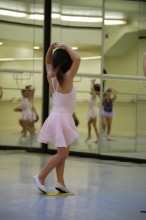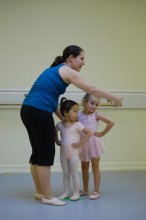“Spread out your arms!”
“Are you touching someone else?”
“If you are, then you are too close together!”
Broken record.
We all know this is common for helping young dancers manage the space around them when they dance.
Even adults have trouble managing the space around them. It’s a hard concept, don’t you think? Some days (usually Mondays) on my subway ride to work, I just want to call out “Ok, everyone! It’s time for a spatial awareness lesson!”
I so want to!
 In my time as a teacher, I have grappled with teaching space. There are always those that really understand it, and then there are those who really struggle with it.
In my time as a teacher, I have grappled with teaching space. There are always those that really understand it, and then there are those who really struggle with it.
I feel with preschoolers, it’s an element we have to review at the top of every class. So, how do we teach them about space in a fun and creative way, without sounding like a broken record?
Space Bubble
Ask your students to sharpen their magic pencil (or crayon, if you’re feeling fancy). Ask them to take their finger (pencil) and trace their body to make a big bubble. Now explain that if they get too close to another bubble, it will pop!
“Do you want your bubble to pop?” “No way!”
Physically drawing the bubble is my favorite part. “Make sure you you get in between your toes!”
When the class is dancing through space, you can reference the bubble instead of saying “be careful!” and “watch out!” over and over.
Toast
My friend Jenn told me about this idea and it’s great. Ask your students to imagine that the space you are in (the room) is a piece of toast. Ask them “What should we spread on our toast today?” “Peanut butter!” “Jelly!” “Butter!”
Once you have decided, ask the students to spread it around, standing in a spot on the toast, making sure that every piece of the “toast” is covered. No clumps. We like our jelly evenly spread!
Block Space
Sometimes it helps to use a prop instead of bodies to teach about space. I like to use blocks. Something big-ish.
I give each dancer the prop and ask them to put it on the floor where there are no other blocks around. It should be far apart from the other props and far away from the walls too.
Once they have placed their prop, I ask them to come back to the wall to observe the space. I ask them “Do you see any too close together?” If they do then I ask for a volunteer to fix it so there is enough space around each of the props.
After we observe the props in their own spaces, I reference that this is how we should use the space with our bodies. Each block is far away from the others.
A Box Of Space
One activity I like to use to teach the concepts of personal space (the space you stand in) and general space (the space around you) is to make a box in the room on the floor with tape.
Put everyone inside the box. Ask your students to try to move around in the box— that’s a crowded box! I explain that the empty space outside of the box is general space.
After we spend some time in the box trying to move around, we all come out of the box. One by one I send the students to the box, so they can feel what it’s like to dance in the box without it being crowded. Then they know what it feels like to be in personal space.
I can see a big difference after I do this exercise – they understand personal space and general space.
Space In-Between
One common belief I always see with my preschoolers is “being beside you, means sitting on top of you.”
At the beginning of class, I put spots in a circle and ask my students to sit on them. Almost without fail, a dancer will move their spot right next to their friend. And when I say right next to, I mean on top of – their bodies are absolutely touching.
What kids don’t understand at the preschool age is that a little space is a good thing and that they are still sitting beside their friend even if there is some space in between them. That’s a hard concept to grasp.
I tell them it’s like sitting in a chair. “You and your friend don’t sit in the same chair, right?” “Let’s pretend the spots are chairs and put some space in between you!”
I usually reinforce this one by asking the grown-up to talk to them about it home. It really helps!
Followers
Every once in a while I get students who follow each other around while we’re dancing. Sitting next to your friend at dance is different then following them around the entire class.
I use the “I want to keep you safe” line but I also tell them that I want them to be their own person and use their own brain.
I am famous for saying, “you can follow your friend at the playground, and you can follow them home, but at dance I want you to be your own dancer, and show me your own dancing.” They usually understand the reason, but in the next class, I have to remind them again.
Besides this being a spatial awareness issue, it’s a confidence issue too.
Does anyone else experience their students following each other? Please tell me it drives you totally nuts too!
 Be The Model
Be The Model
When I ask my students to find a spot in the room I say,”Please find your own spot in the room far away from another dancer, and far away from the wall.”
Before I ask them to do that, I model it. I ask a dancer to find a spot in the room, and then I find a spot very very close that dancer, touching them.
“Is this my own spot?” I ask. “No!” they say.
Then I go lean against the wall. “Is this my own spot?” “No!”
Then I find an empty space, “Is this my own spot?” “Yes!”
Using poly spots or tape lines are, of course, another way of spacing out your dancers, but the ideas in this post are ways to get them to understand space and how it is used in dance class and in their daily lives.
For a few more ways to talk to students about Space, see Inside, Outside and Through by Stacey Pepper Schwartz.
To see how lessons on space can improve other kinds of skills in dancers, see I’m a Better Backpacker Thanks to Ballet.
How do you teach space to your preschoolers?
How do you keep them safe in space? I would love to hear your creative ideas!
A passionate advocate for early childhood dance education, Maria Hanley Blakemore specializes in teaching ages 0 months to 6 years. She left NYC, where she designed and implemented programs at Manhattan’s Jewish Community Center, Dancewave Center and The Mark Morris Dance Group, to teach dancers in the greater Cleveland area. Maria holds a Master’s degree in dance education from New York University (2007) and a Bachelor’s degree in dance performance from Slippery Rock University in Pennsylvania (2005). Maria authors the blog Maria’s Movers (www.mariasmovers.com) where she shares creative ideas and strategies for teaching young dancers. Maria served on the Dance/NYC Junior Committee for 2 years and presented at the 2012 Dance USA Conference. She also presents at the Dance Teacher Summit in New York City. Read Maria’s posts.

